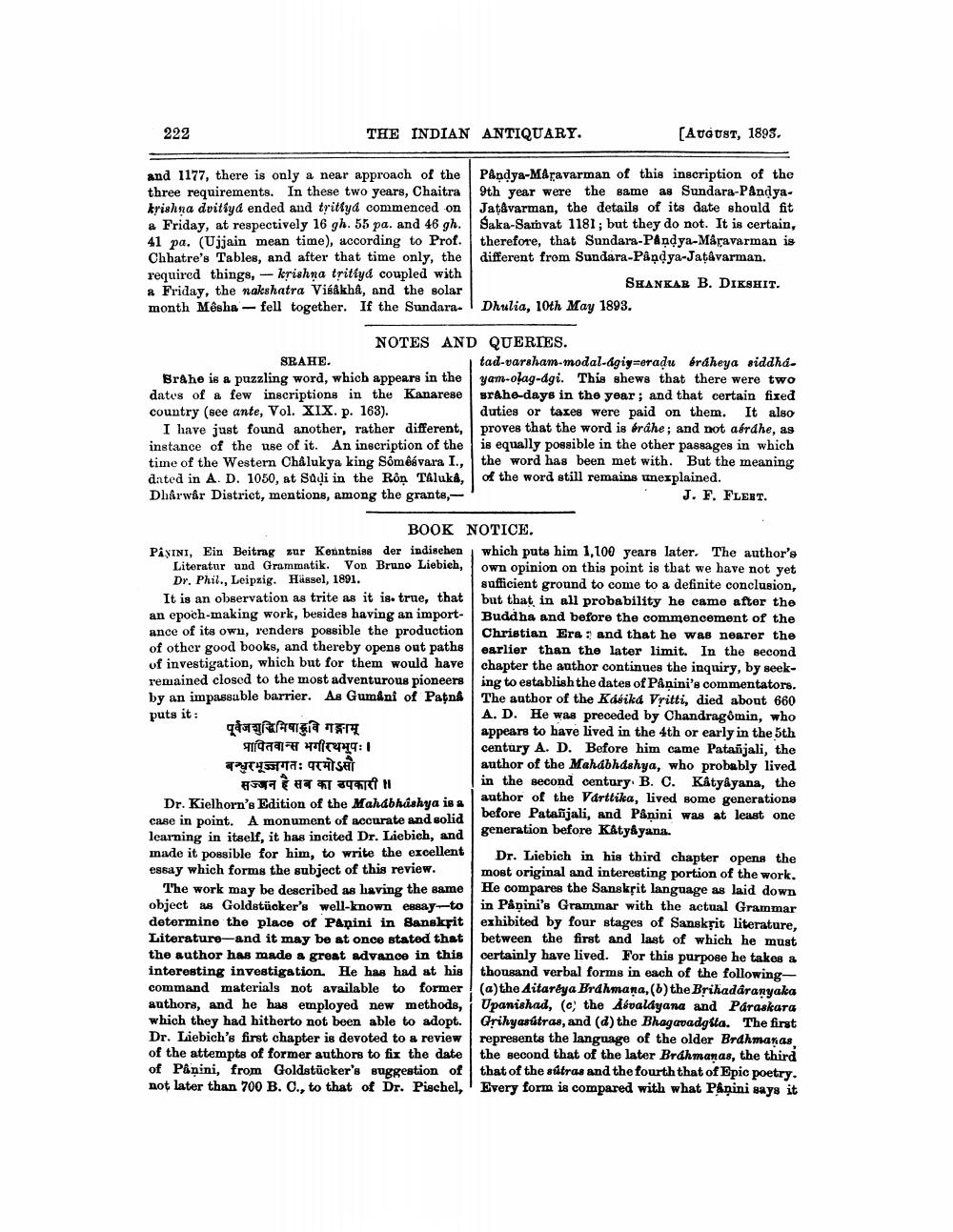________________
222
THE INDIAN ANTIQUARY.
(AUGUST, 1893.
and 1177, there is only a near approach of the three requirements. In these two years, Chaitra krishna dvittyd ended and tritiya commenced on a Friday, at respectively 16 gh. 55 pa. and 46 gh. 41 pa. (Ujjain mean time), according to Prof. Chhatre's Tables, and after that time only, the required things, - krishna tritiyd coupled with * Friday, the nakshatra Việåkha, and the solar month Mêsha - fell together. If the Sundara.
Pandya-Máravarman of this inscription of the 9th year were the same as Sundara-Pandya. Jatavarman, the details of its date should fit Saka-Samvat 1181; but they do not. It is certain, therefore, that Sundara-Pandya-Måravarman is different from Sundara-Pandya-Jatavarman.
SHANKAR B. DIKSHIT. Dhulia, 10th May 1893.
NOTES AND QUERIES. SRAHE.
tad-varsham-modal-agiy=eradu bráheya siddhaBraho is a puzzling word, which appears in the yam-olag-dgi. This shews that there were two dates of a few inscriptions in the Kanarese srahe-days in the year; and that certain fixed country (see ante, Vol. XIX. p. 163).
duties or taxes were paid on them. It also I have just found another, rather different, proves that the word is óráhe; and not aérdhe, as instance of the use of it. An inscription of the is equally possible in the other passages in which time of the Western Chalukya king Sômêsvara I., the word has been met with. But the meaning dated in A. D. 1050, at Sadi in the Rôn Taluka, of the word still remains unexplained. Dharwar District, mentions, among the grants,
J. F. FLEET.
BOOK NOTICE. PAȘINI, Ein Beitrag zur Kenntniss der indischen which puts him 1,100 years later. The author's
Literatur und Grammatik. Von Bruno Liebich, own opinion on this point is that we have not yet Dr. Phil., Leipzig. Hässel, 1891.
sufficient ground to come to a definite conclusion, It is an observation as trite as it is true, that
but that in all probability he came after the
but that in all probability ha an epoch-making work, besides having an import- Buddha and before the commencement of the ance of its owu, renders possible the production Christian Era : and that he was nearer the of other good books, and thereby opens out paths earlier than the later limit. In the second of investigation, which but for them would have chapter the author continues the inquiry, by seekremained closed to the most adventurous pioneers ing to establish the dates of Pånini's commentators. by an impassable barrier. As Gumäni of Patná The author of the Katika Vritti, died about 660 puts it :
A. D. He was preceded by Chandragðmin, who पूर्वजशुद्धिमिषावि गङ्गामू
appears to have lived in the 4th or early in the 5th प्रापितवान्स भगीरथभूपः।
century A. D. Before him came Patañjali, the बन्धुरभूज्जगतः परमोऽसौ
author of the Mahabhdshya, who probably lived सज्जन है सब का उपकारी।
in the second century. B. C. Kâtyâyana, the
author of the Varttika, lived some generations Dr. Kielhorn's Edition of the Mahabhúshya is a
before Patañjali, and Pånini was at least one case in point. A monument of accurate and solid learning in itself, it has incited Dr. Liebich, and
generation before Katyayana. made it possible for him, to write the excellent | Dr. Liebich in his third chapter opens the essay which forms the subject of this review. most original and interesting portion of the work.
The work may be described as having the same! He compares the Sanskrit language as laid down object as Goldstücker's well-known essay-to in Panini's Grammar with the actual Grammar determine the place of Panini in Sanskrit exhibited by four stages of Sanskrit literature, Literature and it may be at once stated that between the first and last of which he must the author has made a great advance in this certainly have lived. For this purpose he takes a interesting investigation. He has had at his thousand verbal forms in each of the followingcommand materials not available to former (a)the Gitaréya Brdhmana, (b) the Brihadaranyaka authors, and he has employed new methods, Upanishad, (c) the Asvaldyana and Paraskara which they had hitherto not been able to adopt. Grihyasútras, and (a) the Bhagavadgita. The first Dr. Liebich's first chapter is devoted to a review represents the language of the older Brahmanas of the attempts of former authors to fix the date the second that of the later Brahmanas, the third of Pânini, from Goldstücker's suggestion of that of the sátras and the fourth that of Epic poetry. not later than 700 B. O., to that of Dr. Pischel, Every form is compared with what Påņini says it




